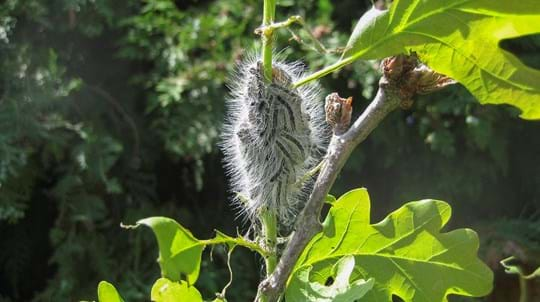
Pests and diseases
Oak Processionary Moth
A threat to both human and animal health.

Head of Tree Health, Forest Research.
At the start of this year, scientists at Forest Research moved into their new state-of-the-art tree health laboratories at Alice Holt in southern England.
This new £5.8 million quarantine facility represents a significant expansion of the UK’s capacity to combat tree pests and diseases – threats which continue to emerge due to climate change and globalisation.
A two-storey building, the Holt Laboratory is mostly designated to work on quarantined pests and diseases. Some lab space is also designated for low-risk tasks, as well as offices for tree health staff.
By their very nature, quarantine facilities are complex. Samples are collected during border surveillance on imported goods entering Britain. They then enter the laboratory via controlled routes. Once inside, regulated pests and diseases can be safely studied without contaminating the surrounding environment.
Staff using these areas pass through a changing area where footwear and protective clothing are exchanged. All waste leaving the quarantine areas is destroyed and even the air and water within these spaces are monitored and managed, removing the risk of pests or diseases leaving the building.
During the lab’s construction, another new tree disease was discovered for the first time within the UK. As tree health colleagues from various organisations work to understand the extent and biology of Phytophthora pluvialis, the new Holt Laboratory is being put to good use by the pathologists within Forest Research.
Similarly, our entomologists are using the new facility (and our new mobile lab) to support national efforts to combat ongoing pest outbreaks, including oak processionary moth (OPM) and Ips typographus.
Having a quarantine facility enables our scientists to look beyond our shores at other emerging potential threats from abroad, working on international collaborations to understand the potential risks of some pests and diseases to our trees. Developing possible control mechanisms is increasingly important, not only to protect our existing trees and woodlands, but also as new wooded landscapes are created.
The investment in the new quarantine facility is being complemented by Defra in a new virtual Centre for Forest Protection, jointly led by Forest Research and the Royal Botanic Gardens Kew. The project will bring together tree health expertise from the UK and the rest of the world to seek solutions to existing and future tree health problems.
In addition to the Holt Laboratory, further investment has included new lab space at our research facility in Scotland: The Northern Research Station. We are also able to upgrade our entomology reference collection to museum-standard storage. These are research facilities designed to support the work of plant health inspectors and to provide evidence for government policy.
Monitoring and surveillance for tree pests and diseases is an essential aspect of tree health management. Information and potentially infected/infested samples relating to the status of our trees are all important to tree health professionals and citizen science, and projects such as Observatree are a valuable component of the UK’s ability to manage tree health.
This is recognised not only by the investment in the new Observatree website and its continued funding, but by developments that we are making to TreeAlert, the mechanism by which suspected tree pests or diseases can be reported.
Some of these changes are ‘behind the scenes’, improving data exchange between our diagnosticians within Forest Research and plant health inspectors who may be called upon to follow up on a suspected pest or disease reported via TreeAlert. We are also planning further developments to provide more feedback to those who submit information.
Tree health continues to be a subject of concern for many people, organisations and governments. And rightly so, especially given the drive to increase global tree cover to help mitigate aspects of climate change. These investments in the new facilities at Forest Research will help us, working with colleagues from many organisations and with volunteers through projects such as Observatree, to protect the health of trees, woodlands and forests.